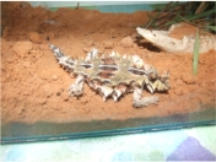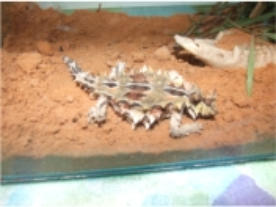

Thorny Devil



The thorny devil (Moloch horridus) is an Australian lizard that is also
known as the thorny dragon, the mountain devil, the thorny lizard, or the
moloch. This is the sole species of
genus Moloch. The thorny devil grows
up to 20 cm (8.0 inches) in length, and
it can live up to 20 years. Most of these
lizards are coloured in camouflaging
shades of desert browns and tans. These
colours change from pale colours during
warm weather and to darker colours
during cold weather. These animals are
covered entirely with conical spines that
are mostly uncalcified.
The thorny devil also features a spiny "false head" on the back of its neck,
and the lizard presents this to potential predators by dipping its real head.
The females are larger than the males. The thorny devil's body is ridged in
structure, and this enables the animal to collect water from any part of its
body. That water is then conveyed to its mouth.
An intimidating array of spikes cover the entire upper side of the body of
the thorny devil. These thorny scales also help to defend it from predators.
Camouflage and deception may also be used by the thorny devil to evade
predation.



Thorny Devil



The thorny devil (Moloch horridus) is
an Australian lizard that is also known
as the thorny dragon, the mountain
devil, the thorny lizard, or the moloch.
This is the sole species of genus
Moloch. The thorny devil grows up to
20 cm (8.0 inches) in length, and it can
live up to 20 years. Most of these
lizards are coloured in camouflaging
shades of desert browns and tans. These
colours change from pale colours
during warm weather and to darker
colours during cold weather. These
animals are covered entirely with
conical spines that are mostly
uncalcified.
The thorny devil also features a spiny
"false head" on the back of its neck, and
the lizard presents this to potential
predators by dipping its real head. The
females are larger than the males. The
thorny devil's body is ridged in
structure, and this enables the animal to
collect water from any part of its body.
That water is then conveyed to its
mouth.
An intimidating array of spikes cover
the entire upper side of the body of the
thorny devil. These thorny scales also
help to defend it from predators.
Camouflage and deception may also be
used by the thorny devil to evade
predation.

This lizard has an unusual gait that involves freezing and
rocking as it moves about slowly in search of food, water, and
mates. The females lay clutch of three to ten eggs during the
September-December season (spring- summer). They put these
in a nesting burrow about 30 centimeters underground. Then the
eggs hatch after about three to four months.
Thorny devils often eat thousands of ants in one day.] They
collect moisture in the dry desert via the condensation of dew on
their bodies at night. This dew forms on its skin, and then it is
channelled to its mouth in hygroscopic grooves between its
spines. During rainfalls, capillary action allows the thorny devil
to suck in water from all over its body















































































